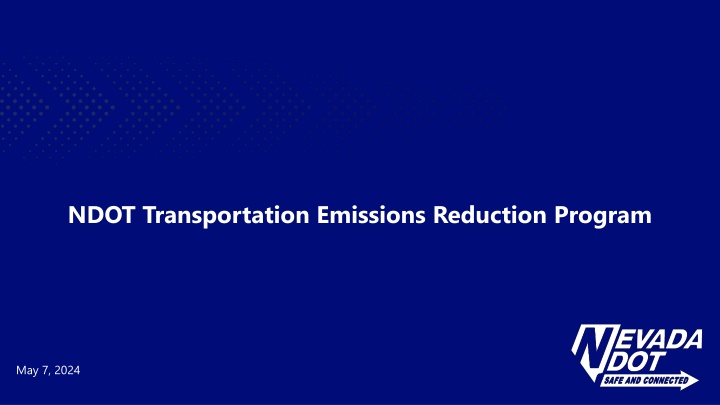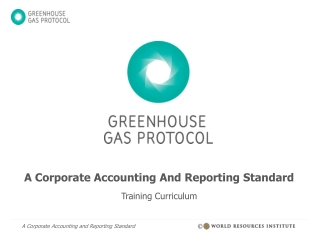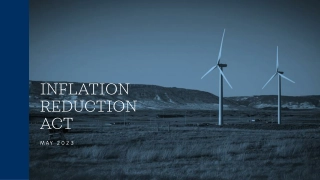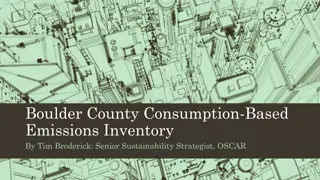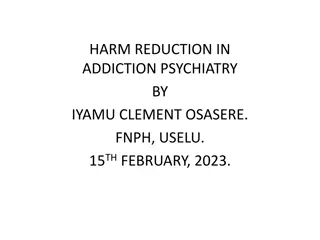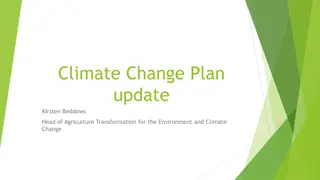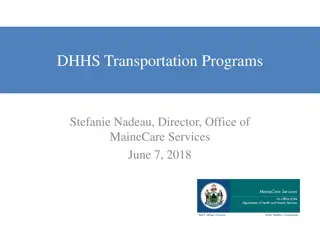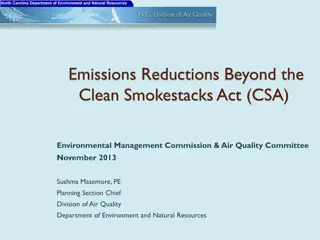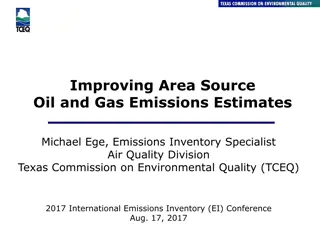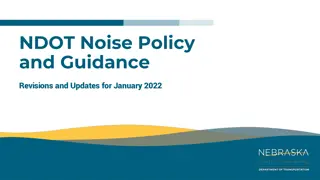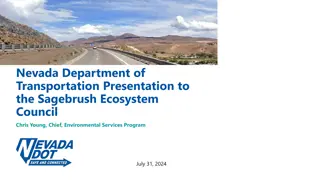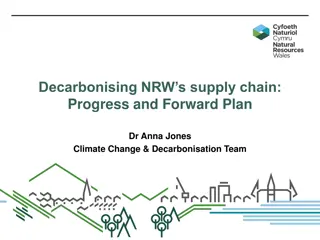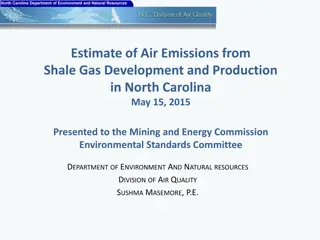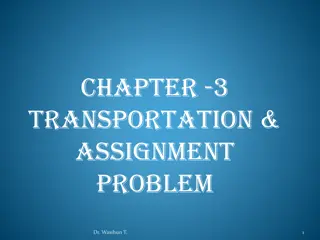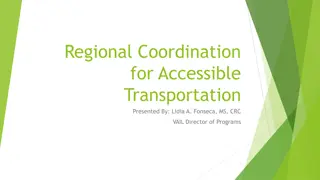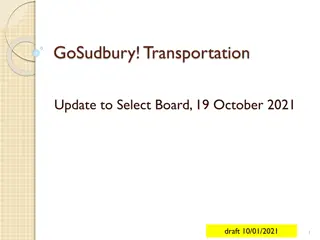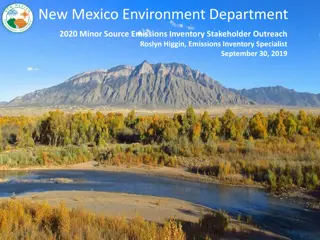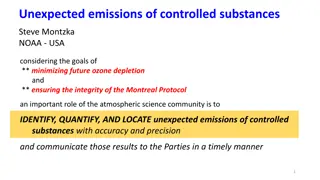NDOT Transportation Emissions Reduction Program
This overview provides information on the NDOT Transportation Emissions Reduction Program, including background, purpose, strategies, and next steps. The program aims to reduce transportation emissions through various projects, strategies, and performance measures. It discusses the development of a State Carbon Reduction Strategy and the importance of public involvement in the process.
Download Presentation

Please find below an Image/Link to download the presentation.
The content on the website is provided AS IS for your information and personal use only. It may not be sold, licensed, or shared on other websites without obtaining consent from the author.If you encounter any issues during the download, it is possible that the publisher has removed the file from their server.
You are allowed to download the files provided on this website for personal or commercial use, subject to the condition that they are used lawfully. All files are the property of their respective owners.
The content on the website is provided AS IS for your information and personal use only. It may not be sold, licensed, or shared on other websites without obtaining consent from the author.
E N D
Presentation Transcript
NDOT Transportation Emissions Reduction Program May 7, 2024
Talking Points 1. Background 2. Methodology and Analysis 3. Key Themes 4. Strategies/Project Examples 5. Performance Measures 6. Public Involvement 7. Next Steps
1 Background
Background November 2021: President signed the Infrastructure Investment and Jobs Act (IIJA) Public Law 117-58, also known as the Bipartisan Infrastructure Law (BIL) BIL authorizes a new Carbon Reduction Program (CRP) to reduce transportation emissions FHWA requires the development of a State Carbon Reduction Strategy for transportation by November 2023 In consultation with MPOs Shall support efforts to reduce transportation emissions, and identify projects and strategies to reduce these emissions States and MPOs are encouraged to obligate CRP funding for projects that support implementation of the State s Carbon Reduction Strategy.
Purpose of the Transportation Emission Reduction Program Review/evaluate best practices for transportation carbon reduction Develop a Transportation Emissions Reduction Working Group Review transportation strategies that could reduce transportation carbon emissions Strategies include policies, programs and/or projects Determine the baseline for transportation emissions in Nevada Determine program performance measures For informing transportation decisions at NDOT and providing guidance to local and regional agencies
Purpose of the Transportation Emission Reduction Program Identify roles/agencies with the ability to implement various strategies Determine eligible formula and discretionary funding sources for strategies, programs, and projects identified Provide guidance on incorporation with Congestion Mitigation and Air Quality (CMAQ) program in coordination with Metropolitan Planning Organizations (MPOs) Develop State Carbon Reduction Strategy document
2 Methodology and Analysis
Methodology Overview Strategies, Project Examples, and Performance Measures Refinement Implementation and Funding 2 4 Building the NDOT Carbon Reduction Strategy National and Statewide Strategies Evaluation Moving Forward 1 5 3
Building the Carbon Reduction Strategy Identification of performance measures and goals Prioritization of strategies and projects Development of project examples Determination of NDOT key themes and strategy grouping Evaluation of strategies Public involvement Identification of initial strategies Ongoing agency and stakeholder coordination
3 Key Themes
Key NDOT Themes Multimodal Mobility Develop an integrated transportation system with a focus on low-carbon transportation modes. Energy Construction Management Incorporate sustainable practices and strategies into the construction of transportation infrastructure. Efficiency Diversification Transition to a wider range of renewable and low-carbon energy sources to reduce reliance on fossil fuels. Implement measures across the transportation sector to improve fuel efficiency and optimize energy usage. Process Enhancement Improve business processes and procedures to enable the adoption of sustainable practices that minimize environmental impacts. Partnership and Collaboration Congestion Management Address traffic congestion and improve traffic flow to promote a more sustainable transportation system. Foster alliances and collaborations among stakeholders to achieve carbon reduction goals.
Federal Goals Versus NDOT Themes Facilitate approaches to the construction of transportation assets that result in lower transportation emissions as compared to existing approaches. Facilitate the use of vehicles or modes of travel that result in lower transportation emissions per person-mile traveled as compared to existing vehicles and modes. Reduce traffic congestion by facilitating the use of alternatives to single-occupant vehicle trips. Federal Goals Process Enhancement Partnership and Collaboration NDOT Themes Construction Management Efficiency Congestion Management Energy Diversification Multimodal Mobility
4 Strategies/Project Examples
Strategies/Project Examples Theme Tier 1 Strategies Tier 1 Project Examples Implement Truck Parking Information Management Systems. Address greenhouse gas emissions in State-level freight planning. Reduce Emissions from trucks Efficiency Adopt Low-Carbon Fuel Standards Adopt a low-carbon fuel standard for transportation fuels. Promote the use of low-carbon and sustainable materials, such as low-carbon-intense asphalt for roadway construction. Recycle and reuse materials as part of maintenance repair, replacement, and rehabilitation activities. Develop project specifications and requirements in the construction of transportation projects for the reduction of carbon. Construction Management Promote Practices Implementation Green Construction Expand EV Charging Infrastructure Install EV charging infrastructure at public parking lots and shopping centers Establish Programs Zero-Emission Truck Implement targeted pilot projects and financial incentives to accelerate the transition of medium- and heavy-duty vehicles to zero-emission vehicles Energy Diversification Promote Electric Buses Adoption Pursue funding options through grants and other methods to subsidize alternative fuel transit buses Implement sustainable measures, such as waste management, electric toll collection, and solar energy generation systems at transit facilities. Improve transit services through increases in trip frequency, expanded service areas, and enhanced reliability. Reduce Transit-Oriented Emissions Multimodal Mobility Create a well-connected network of pedestrian and bicycle infrastructure. Support shared micro mobility programs. Update the statewide bicycle plan. Improve Carbon Transportation Options Accessibility of Low-
Strategies/Project Examples Theme Tier 1 Strategies Tier 1 Project Examples Implement a Quantitative GHG Measure for the Project Prioritization Process Include GHG reduction as a criterion for project prioritization. Establish targets for GHG reduction and track progress toward meeting these targets. Process Enhancement Include GHG Reduction as an Objective for TSMO Under the "Foster Sustainability" Strategic Goal Include GHG reduction as an objective for the TSMO plan. Develop specific targets and measures for this target, monitor the progress, and adjust as needed. Establish joint task forces or working groups to share knowledge and best practices in reducing transportation emissions. Become a Clean City through the Clean Cities Coalition. Promote Agency Partnership Partnership Collaboration and Integrate climate change considerations into transportation planning and design processes. Conduct vulnerability assessments to identify transportation infrastructure at risk from climate change. Promote Resilience to Climate Change Impacts Prioritize projects that enhance real-time traveler information Implement adaptive traffic signal control technologies Implement Congestion Mitigation Strategies Implement adaptive traffic signal control technologies Plan maintenance activities to reduce delays or unnecessary travel. Congestion Management Improve Roadway Operations and Maintenance Implement Trip Reduction and Transportation Demand Management Strategies` Implement active parking management.
5 Performance Measures
Program Performance Measures Percent adoption of low-carbon and renewable fuels Efficiency 1 Percent reduction in the carbon intensity of transportation fuels Process Enhancement Number of projects that are prioritized based on their greenhouse gas reduction potential 5 Percent reduction of GHG emissions from roadway construction Construction Management Number of successful joint initiatives/programs to reduce carbon emissions and number of government agencies, private industry partners, community groups, or other organizations actively engaged in the collaborative programs 2 Number projects implemented that included requirements/incentives for green construction methods Partnership and Collaboration 6 Number of EVs and AFVs registered/sold within a specific timeframe ((including number of zero-emission trucks) Percent of stakeholders satisfied with the partnerships Energy 3 Diversification Vehicles miles traveled (VMT) reduction Number of alternative fuel buses integrated into the public transit fleet Congestion Management Travel Time Index and planning time index 7 Reduction in single-occupancy vehicle trips and increase in low-carbon transportation mode share Improvement in air quality Multimodal Mobility 4 Walkability and bikeabiliy Index
6 Public Involvement
Public Involvement Campaign Online public involvement campaign through the NDOT website from October 27 to November 10, 2023 Survey asked participants: To rank their level of support for proposed strategies and projects (strongly supportive, supportive, neither unsupportive nor supportive, unsupportive, strongly unsupportive) If they have any questions or comments on the strategies Requested optional information from respondents including name, email, zip code, and ethnicity/race Campaign included a video to provide information on the CRS, and an online survey to gather insights Online and social media ads used to encourage survey participation, along with emails to stakeholder groups throughout Nevada
Public Involvement Campaign What We Heard 479 responses Responses by location Category Responses Urban 237 Non-urban 41 Outside Nevada 17 No Zip Code Provided 184 Total 479
7 Next Steps
Status to date Carbon Reduction Strategy Submitted document to FHWA November 15, 2023 Approval from FHWA received February 20, 2024 Working on calculating emission reduction potential from proposed strategies (qualitative and quantitative) Development of full Transportation Emissions Reduction Program
Next Steps A mix of traditional and innovative funding mechanisms will provide NDOT the flexibility needed to support both near-term priorities and long-term investments. To successfully execute the initiatives within the CRS, NDOT will explore and leverage a range of funding, financing, and implementation options. NDOT will collaborate with partnering agencies to identify creative solutions that attract investment through shared benefits.
